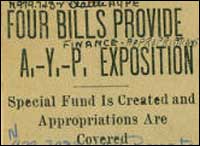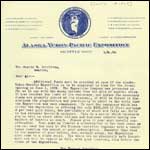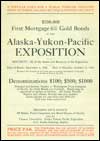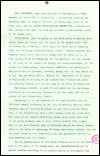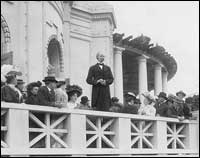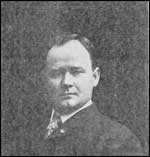|
Conception and PlanningThe original idea for the AYP is credited to Godfrey Chealander. Charged with coordinating an Alaska exhibit for the Lewis and Clark Exposition in Portland in 1905, Chealander felt an event of more economic significance should be held to celebrate Alaska. He shared his idea with William Sheffield, secretary of the Alaska (later Arctic) Club and James A. Wood, city editor of the Seattle Times, who both began promoting the idea of the Exposition immediately. Wood began to run stories in the Times promoting the idea of holding an Alaska exposition and soon gained support from both the Chamber of Commerce and the public. In early 1906, several members of the Chamber of Commerce decided to form an Exposition Corporation with the idea of holding the exposition in 1907. 1907 seemed a perfect date because it was the 10th anniversary of the discovery of gold in the Klondike. The Chamber members elected John E. Chilberg, a prominent local banker, as the president of the AYP Corporation. Several members of the Chamber became officers of the Corporation. Later, when the planners discovered that the Jamestown Exposition was to be held in 1907, the date of the AYP was changed to 1909, allowing it to be advertised as the “Fair that will be ready.” Both the state and federal legislatures were approached for support. Past governor McGraw and Washington's congressional delegation successfully lobbied Congress for funding. In May 1908, Congress appropriated $600,000 for the AYP to be spent on U.S. government buildings and exhibits. A major decision about the AYP was the location. On June 16, 1906, Professor Edmond Meany proposed that the University of Washington campus be used as the site. The campus at that time was mainly unplanned forest and contained only seven permanent buildings. Those opposed to the campus site argued that it was too far out in the suburbs but Meany pointed out its accessibility by streetcar, the sightseeing opportunities for non-Seattleites, and the advantages of the breathtaking vistas of the Cascades and Olympics. Using the campus as the site of the Exposition also offered the advantage of a double use of funds invested in the project—helping the Fair, and developing the University. One serious objection came from the prohibition of the use of alcoholic beverages on the campus which it was felt might lower the profits from the Fair. In the end, however, it was decided that prohibition was a small price to pay for the use of such a large, beautiful, and accessible site. As the talk of the Exposition continued to gain support, the idea broadened. At first the scope was expanded to include the Yukon Territory and the Exposition became the Alaska-Yukon Exposition. But seeing the economic and political advantages when publicity director Henry Reed suggested the scope be widened to include all of the countries bordering the Pacific, the Exposition became the Alaska-Yukon-Pacific Exposition. Emissaries were sent out to China, Japan and Hawaii. Chilberg went to Ottawa where he obtained assurance of Canadian participation. Forty-five other states were visited, some by Professor Meany, with Hawaii, California, Oregon, Utah, and Idaho agreeing to participate. By June 1, 1906, the Times noted that the scope of the fair would “take in all the countries bordering upon the Pacific Ocean, including the islands of the sea.” Fifty Seattle businessmen and women became members of the Exposition Corporation. The Corporation began fundraising for the Exposition by launching a drive to sell stock to Seattle investors. When more than $500,000 was pledged in a one-day subscription on October 2, 1906, the investors felt that they had the support from the people of Seattle needed to create a successful fair. Later, when the push for financial support became stronger, letters were sent not only to people who had already donated, but also to those who had not yet done so. |




